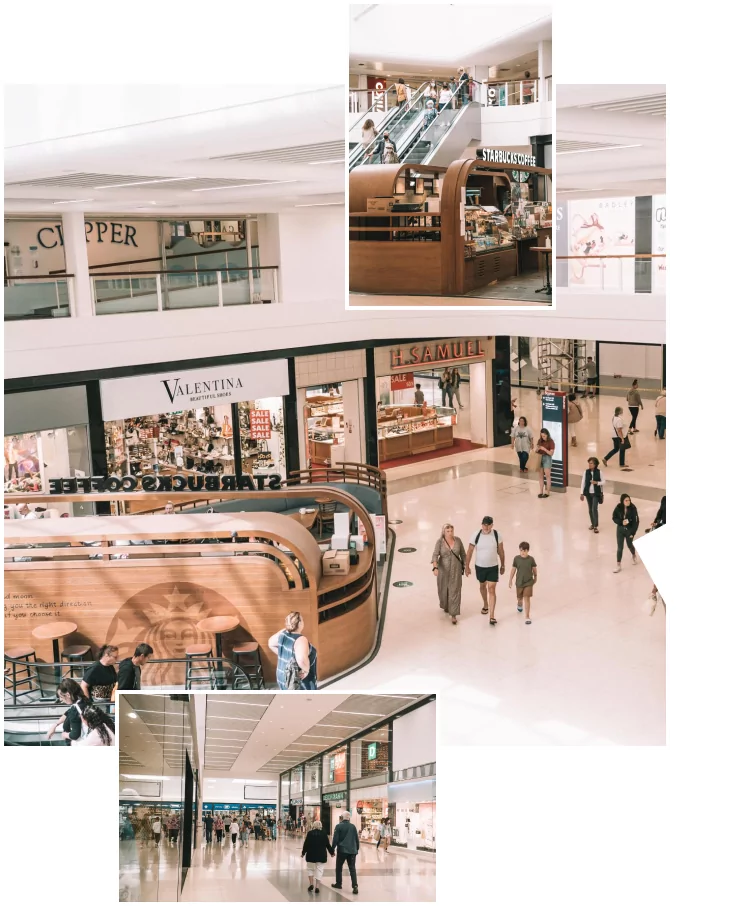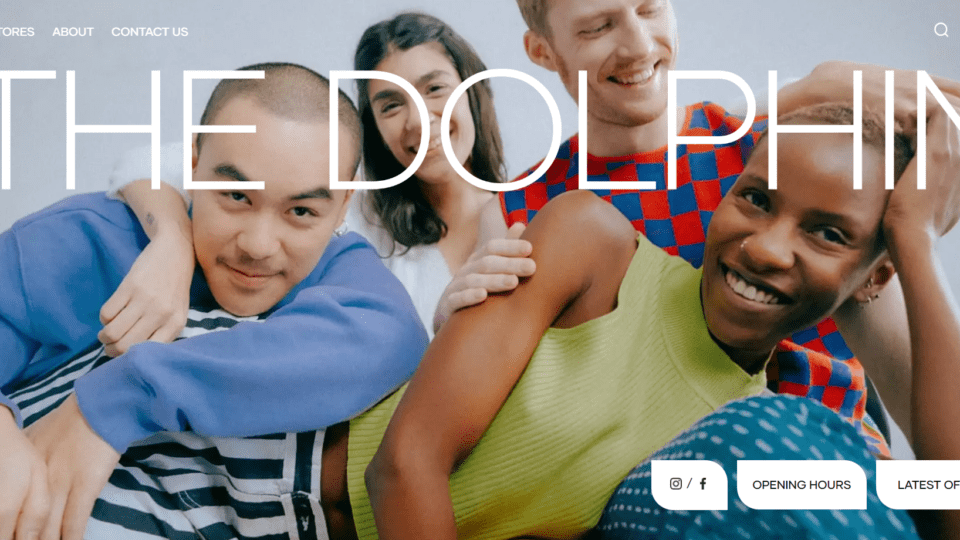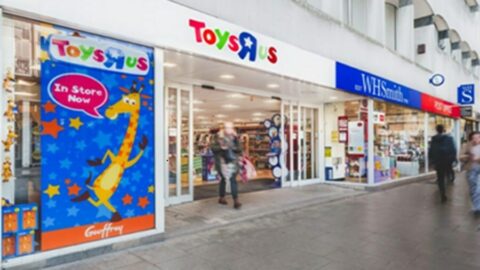Shopping malls are on the rebound thanks to Gen Z’s hunger for nostalgia and community. But that doesn’t mean these commerce destinations don’t need a major overhaul. Experts indicate that the root of shopping malls’ “identity crisis” is their inability to effectively leverage data to curate experiences that represent the full scope of consumers’ needs and lifestyles.
That is, until Dolphin Centre in the UK. Also known as The Dolphin, this Dorset, England-based mixed-use destination combines retail, healthcare, co-working space and community-driven activations.
The experience has been thoughtfully crafted and refined to provide consumers a rich cornucopia for commerce, community and cultural experiences. At the center of this new vision and strategy is Denz Ibrahim, Head of Retail and Futuring for global asset manager Legal & General Investment Management (LGIM), who implemented a long-term transformation initiative that encourages both property owners (landlords) and tenants (retailers, restaurants, artists and other small business owners) to work together, better.
After all, Ibrahim admittedly isn’t a “real estate guy,” he is a designer by background and joined LGIM to “completely reinvent and rethink how we do retail spaces within the business,” he recounted in an interview with Retail TouchPoints. “That sits along two strands: one being, how do you shift the culture internally? How do we shift the way our asset managers approach these assets?” Ibrahim explained. “The second is how do we spatially, on the front end, begin to reframe and pivot the perception of our assets, which stretches across all consumer-facing environments?”
It is this line of thinking that has made Dolphin Centre a valuable real estate investment for retailers such as Clarks, H&M and River Island, and a meaningful community destination for consumers.
Rethinking Retail Real Estate Culture
At a fundamental level, Ibrahim noted that real estate owners need to shift the way they think about their relationships with retailers of all sizes and other local business owners: “They have to shift from what I call ‘librarians,’ who are quite old, static and inflexible owners that collect rent and clean spaces, and become editors,” he explained. “That means being much more content-focused and more audience-focused.”
Advertisement
To support his team’s efforts to build and expand The Dolphin, Ibrahim helped develop key strategic pillars for a future retail blueprint, “which is all about creating a consumer-centric narrative, curating iconic environments across the UK, and fixing an out-of-date leasing system that is one-size-fits-all and is more of a barrier,” he said. “We had to create a springboard and then design a toolkit for future-fit places — an array of back-end and front-end products as well as curating and operating markets and events, to rethinking the public realm as the new anchor to glue all of these environments together.”
Reframing the Shopping Mall Brand

Ibrahim is adamant that The Dolphin isn’t really a “shopping center” anymore, but that’s definitely what it was more than three years ago when he started his tenure at LGIM. The “sad-looking space” was about 70% occupied and “unloved” strategically. The LGIM team devised a three-pillar strategy — Reframe, Remodel, Reposition — to support the center’s transformation.
The goal was to “reframe for minimum CapEx, maximum impact, and reframe the role of the asset in the town,” Ibrahim explained. They also wanted to “go beyond just buying products on shelves and reframing the customer experience. Remodel is all about diversifying the mixed-use environment and the different types of occupiers and diversifying revenue streams. And the last piece is reposition, which is all about driving long-term, future-fit environments by building out healthcare, education and residential.”
To embark on this transformation, The Dolphin went through a multi-stage process that included the launch of four core offerings within and surrounding the core real estate space:
- Kingland, a series of shops located on Kingland Crescent designed to create an easy entry point for small businesses to open their own stores;
- Street Market, which allows independent artisans to rent stalls to sell goods, akin to a farmer’s market;
- Gather, a dedicated space for community members to host events and curate activations; and
- Foundry, a co-working space that also includes various technologies and services to support business operators and their employees.
Phase one of the development journey was dedicated to launching Kingland, a High Street area of 10 shops dedicated to independent brands. By offering brands these spaces rent-free for two years, LGIM was able to not only reframe the assets but pivot the perception among consumers and businesses alike. “We felt there was a real missed opportunity within this region to develop a creative hub where independent brands and entrepreneurial people could launch their ideas and get them in front of their community,” Ibrahim said.
Within this two-year period, the spaces accommodated a coffee roaster, a mid-century furniture repair shop, an art gallery, a gin-tasting concept and more. Although offering free rent may seem like a significant expense to some, Ibrahim noted that it was a long-term investment that ultimately paid off: 60% of those brands are now paying rent and have stayed in Kingland because “they wanted to be a part of this story,” Ibrahim added.
Kingland was the “springboard” to help Ibrahim and his team pivot perception and look at the real estate asset more holistically. The team went on to launch Street Market, which gives artisans and creators, from jewelers to bakers, artists, candlemakers and other young, independent brands, rentable kiosks where they can sell to consumers. With its low price point and flexible leasing model (business owners can rent space by the day), Street Market provides an entry point to merchants “that never had a place to launch in their community before,” Ibrahim said.
Gather was then unveiled to be a physical platform and free space for community organizations and even individuals to host events: “It’s about us saying, as a landlord, that we’re not the ones launching events. That’s not what we’re good at. But we’re good at understanding our audience and creating a platform for the community to launch events in this space,” Ibrahim said. The events calendar is dynamic and ever-changing, including everything from yoga classes to kids’ clubs, charity events and even community date night events.
“[Creating this hub] allowed us to create a new audience that came to the shopping center that never would have come before,” Ibrahim explained. “It created programmability, change and curation, and it allowed us to work closely with our occupiers to really understand how this was impacting their revenue streams.”
Remodeling the Experience
Once LGIM was able to reframe the shopping mall experience, it was able to remodel more space to drive more audience acquisition. For example, it launched a 20,000-square-foot health clinic at the center of the shopping center. Within the first six months, they found that 57% of those patients were ultimately going on to shop in the center after their medical visits.
Additionally, they launched an adult education center, which helped create a relationship between the college, the shops and the market, as well as adding an 18,000-square-foot co-working space called Foundry. The end result was a powerful cycle of engagement and a cohesive environment where visitors could learn, work, connect and, of course, shop.
“It’s all about creating incubation,” Ibrahim explained. “We created a space where we could say, if you just graduated [from school] as a nail technician you can launch your nail bar downstairs in the market, grow your business, rent a desk upstairs in the co-working space and begin to create your own self-generated demand within our community. Every year that will scale up.”
LGIM has hired curators, who are continuing to build upon this foundational strategy to create a more expansive shopping center experience. For example, a street food concept is in the works.
“We’ve diversified the audience, we’ve diversified the rhythm of people coming to the center and suddenly you can begin to connect these experiences,” Ibrahim noted. “This all exists while retail is still 40% to 45% of the footprint — and it is functioning and performing very well. We aren’t anti-retail. We are shrinking the amount of retail, but the retail is better quality and sits alongside a holistic, future-ready retail asset, which is sustainable in income and keeps the visitors engaged and excited.”
The ultimate goal for LGIM is to understand how consumers are behaving within these properties, including journeys, footfall, dwell time, demographics and even social media behavior, so they can respond in an agile fashion, according to Ibrahim. “The constant struggle is to balance the world of retail real estate, which is historically very fixed, inflexible and run by spreadsheets, with a consumer who is ever more demanding, and have higher expectations than ever.”









